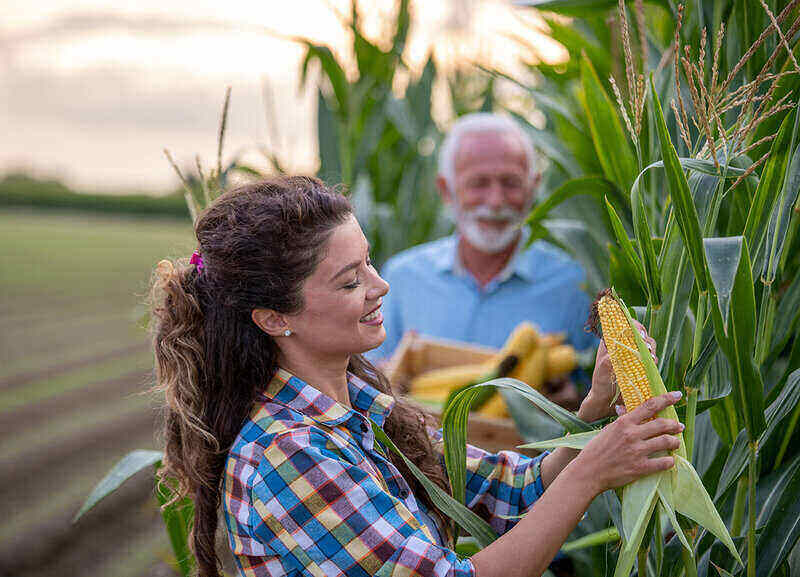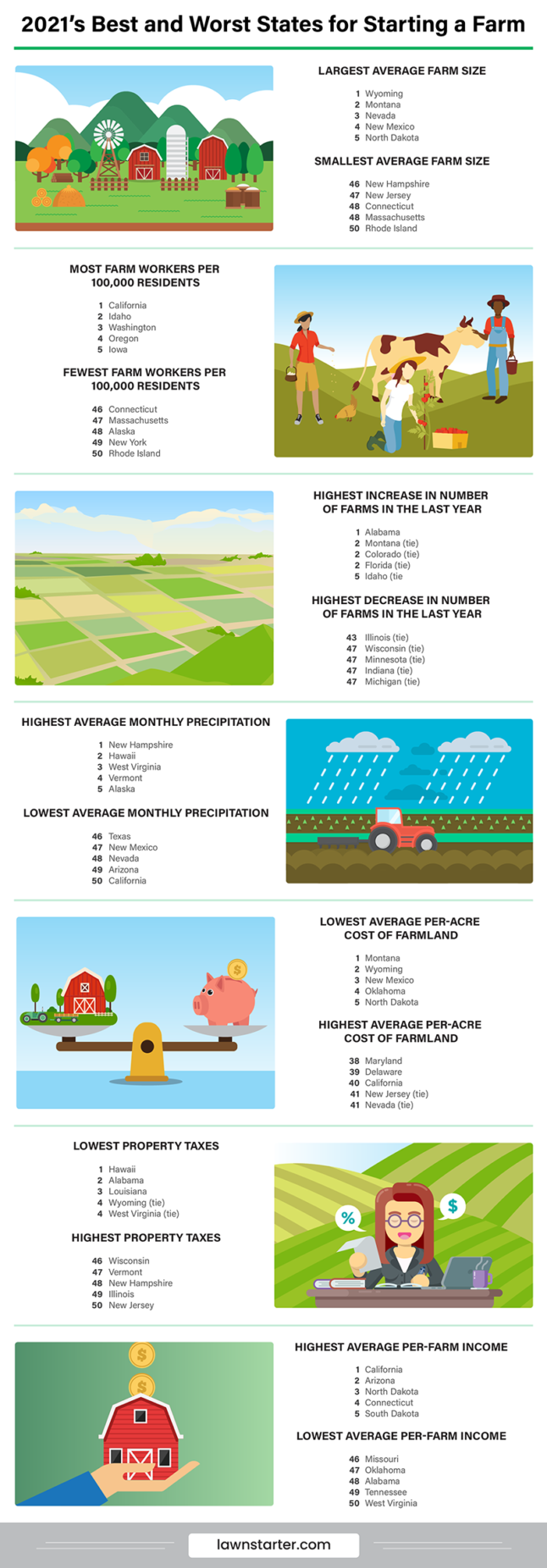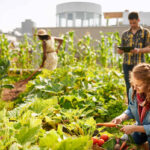
Farming and ranching aren’t the most glamorous jobs — you’re up before sunrise tilling the soil and milking the cows, and you work 365 days a year. Despite the rigorous work schedule, agriculture is among the most rewarding and essential professions.
But where do you have the highest chance of successfully starting a Green Acres life?
Ahead of Farmers Day, Oct. 12, LawnStarter compared the 50 states across 42 key metrics to rank 2021’s Best States to Start a Farm or Ranch.
We looked for states with existing farm communities to indicate viability, good infrastructure, and a suitable climate. We also compared the states based on overhead and ROI potential.
See which states are best for getting your hands dirty below, followed by some highlights and lowlights.
Table of Contents
State Rankings
See how each state fared in our ranking:

Highlights and Lowlights
Montana: Ahead of the Herd
The Big Sky State earns the top spot in our ranking of 2021’s Best States to Start a Farm or Ranch. With agriculture its biggest industry, Montana’s victory comes as little surprise.
The state placed in the top 10 in five out of seven categories and No. 15 in ROI Potential. Montana trails only Wyoming in farm size, averaging a whopping 2,156 acres, and the average cost of an acre in the Treasure State is lowest in the U.S.
Although ranching is woven into the state’s cultural fabric, farming also contributes significantly to the state’s economy. Montana is a top supplier of beef, and it leads the nation’s production of organic certified wheat, dry peas, lentils, flax, and honey.
If you want the best of both worlds, Montana hits the sweet spot.
Great Plains: Great for Agriculture
Nine of our top 10 states are in the Great Plains, including several in the Corn Belt. Those regional names alone give away these states’ suitable farming qualities.
Coming in at No. 2 is Kansas, while Texas clocks in at No. 4, Oklahoma at No. 5, and Iowa in seventh place. Both Dakotas made it, too, at Nos. 3 and 6. Colorado (No. 9) and Wyoming (No. 10) round out the Plains states at the top.
But how specifically did this broad, sweeping landscape dominate the top of our ranking? Most of these states, such as Kansas, Oklahoma, and Texas, boast cheap land, large established farming communities for support, and highly developed infrastructure.
Move to the Great Plains, and you’ll be chasing cattle in no time.
The Last Frontier: Last in Farming
Alaska not only ranked at the very bottom of our ranking of top agricultural states, but it also finished last in two out of seven categories, Viability and Climate; third to last in Personnel; and in the worst 10 of Infrastructure and ROI Potential.
These results are hardly a shock. Although Alaska is the biggest state by land area, less than a quarter of a percent of the state’s 365 million acres is available for farming. Much of this can be attributed to the state’s generally unsuitable farming climate, brief growing season, and infertile soils.
In other words, you won’t grow many crops here — but you can grow some of the world’s biggest. Because of Alaska’s long daylight hours during summer, some vegetables grow to monstrous sizes: a 19-pound carrot, 76-pound rutabaga, and 172-pound cabbage.
Ask The Experts
Starting a farm or ranch can be challenging, especially if you have no previous experience.
To help you navigate the agricultural business landscape, we reached out to a panel of experts for wisdom. See what they had to say below.
- What are the top three reasons to start a farm or ranch today?
- What type of person is best suited to a career in agriculture?
- What will be the three biggest challenges to new farmers and ranchers over the next 3-5 years?
- Over the long-term, do you see more opportunity in direct-to-consumer farming or industrial supply-chain farming, which has not fared as well during the pandemic? Please explain.
- What’s your single most important tip for someone who wants to start a farm or ranch?



Methodology
We ranked the 50 U.S. states (excluding the District of Columbia) from best (No. 1) to worst (No. 50) based on their overall scores (out of 100 possible points), averaged across all the weighted metrics listed below.
Sources: AcreTrader, National Center for Disaster Preparedness, National Oceanic and Atmospheric Administration, National Transportation Research Nonprofit (TRIP), Nebraska Department of Environment & Energy, Rural Health Information Hub, Tax Foundation, U.S. Bureau of Labor Statistics, U.S. Census Bureau, U.S. Department of Agriculture, U.S. Department of Energy, U.S. Energy Information Administration, U.S. Environmental Protection Agency, WhistleOut and World Population Review
Why This Study Matters
The pandemic made clear that farmers and ranchers are more vital than ever to maintaining our food supply. When it was hard to find toilet paper, there were always fruits, vegetables, and meat for lunch and dinner.
But like many other sectors of the economy, the agriculture industry currently suffers from a massive labor shortage. The consequences could be dire — we need more children of the corn, as well as more citrus growers, calf ropers, and steer herders.
Besides the opportunity to fill this critical employment gap, the financial incentive to join the agriculture industry is stronger than ever: You can make green by growing green crops — this includes marijuana in states where that’s legal.
At the start of 2021, farmers were forecasted to see profits for the first time in many years. Profits from farm exports, in particular, are expected to hit a new record in 2022 after an already record-setting 2021.
So if you’re looking for a career transition, buy the farm or saddle up your horses — the time to enter the agriculture market is now.
Main Photo Credit: Budimir Jevtic | Shutterstock





